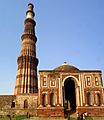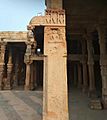Quwwat-ul-Islam mosque facts for kids
The Quwwat-ul-Islam Mosque, whose name means "Might of Islam" or "Glory of Islam," is a very old and important mosque located in Delhi, India. It stands near the famous Qutb Minar. This mosque was built by Qutb-ud-din Aibak, who was the first ruler of the Mamluk dynasty in India. Construction started in 1192 and continued until 1316. It's known as the first mosque built by the Delhi Sultans in India.
Building a New Mosque
Qutb-ud-din Aibak started building the Quwwat-ul-Islam Mosque in 1192. He wanted it to be a symbol of the Muslim conquest of India. The mosque was built quite quickly. To get the materials, Aibak used parts from 27 Hindu and Jain temples that were taken down.
Local craftspeople, who were probably Hindus, helped build the mosque. They reused columns and other pieces from the old temples. However, Islamic rules usually don't allow images of people or gods in mosques. So, the craftspeople had to cover the detailed carvings on the Hindu columns with plaster. Over many years, this plaster has fallen off, showing the original beautiful Hindu carvings underneath.
The Famous Iron Pillar
Inside the mosque's courtyard, there's a very old iron pillar. This pillar is much older than the mosque itself! It was built in the 6th century during the Mauryan dynasty. It's amazing because even though it's made of iron, it has not rusted for over 1,500 years. This shows how skilled the Mauryan people were at working with metal.
The pillar has an inscription written in Sanskrit from the 4th century AD. It says the pillar was set up to honor the god Vishnu and a powerful king named Chandra. There's a deep hole at the top, which suggests an image of a bird-like figure called Garuda might have been placed there. Qutb-ud-din Aibak built the mosque around this ancient pillar, keeping it in its original spot.
Growing Over Time
The Quwwat-ul-Islam Mosque was made bigger and more grand over the years by later rulers. Shams-ud-Din Iltutmish, who ruled from 1210 to 1235, added a tall arched screen and expanded the mosque. Later, Ala-ud-Din Khalji also made additions to the mosque, making it even larger.
Images for kids
-
Close up of the inscriptions on entrance arch, Alai Darwaza built by Alauddin Khalji
-
The ancient ruins of twenty-seven Jain and Hindu temple complex over which a mosque was constructed beside Qutub Minar
-
Intricate stone carvings on the cloister columns at Quwwat ul-Islam Mosque, Qutb complex, Delhi – Resembles Jain Temple Pillars – Pillars taken from Jain temples.
-
The Iron pillar in the Qutb Complex
-
Alauddin Khalji's Madrasa, which also has his tomb to the south, ca 1316 AD
-
Hindu temple ruins in qutub minar
-
Tomb of Alauddin Khalji, Qutb Minar complex
-
Holy Quran verses written on the exteriors of the Qutb Minar

































